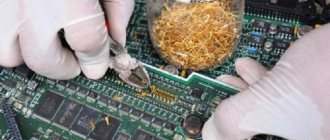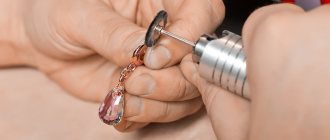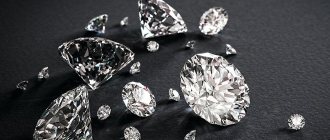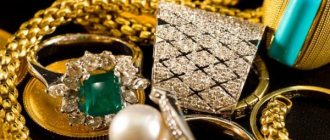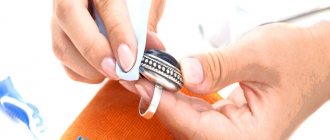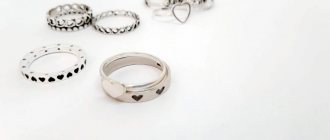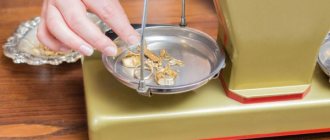What is this procedure and why is it needed?
Galvanization is an electrochemical process of decorative and protective painting of products with metals:
- silver;
- gold;
- zinc;
- copper;
- chrome;
- nickel
Helps strengthen the product and protect the surface of objects from corrosive processes, making their color attractive. The effect is achieved due to the diffusion (penetration of molecules) of the metal into the surface layer of objects, which allows the silver film to be securely fixed.
The essence of the process
The principle of electroplating is the application of one metal to another by electrolysis.
It takes place in several stages:
- The correct composition is selected.
- A pair of anodes is placed from the “plus” of the electric current source into the electrolyte (liquid with high conductivity).
- The workpiece is immersed between the anodes, then connected to the “minus” of the electric current source.
- The chain is closed.
In jewelry, silver electroplating is used for decorative purposes. It is in great demand in industrial sectors. If special reagents and materials are available, electroplating can be carried out at home.
Gilding
| Gold is a malleable and ductile yellow metal with a specific gravity of 19.3 and a melting point of 1063.40C. In chemical compounds, gold is monovalent and trivalent. Gold is resistant to acids and alkalis (with the exception of aqua regia). The thickness of gold electroplating ranges from 0.25 microns to 3 microns. |
The process of galvanic gold plating, as well as silver plating, is carried out in iron-oxide electrolytes (cyanide electrolytes are not used due to extreme toxicity). Products made of copper or nickel are coated with gold directly; gold is not deposited on metal products; they are subjected to preliminary galvanic copper plating or brass plating to a thickness of 30-50 microns. Gold salts are obtained by dissolving gold in aqua regia; for this purpose, the metal is rolled, cut into small pieces and dissolved in a mixture of acids.
Composition of ferrous sulfur electrolyte and gilding mode:
- Gold chloride (in terms of metal) – 1.5 g/l.
- Potassium iron sulfide – 15-50 g/l.
- Anhydrous soda – 20-25 g/l.
- The temperature of the gilding electrolyte is 50-550C.
- Cathode current density – 0.1-0.2 A/dm2.
- Current efficiency – 25-35%
This electrolyte makes it possible to obtain a gold layer of 2.3 microns/hour at a current density of 0.2 A/dm2 and with an output of 30%.
In electroplating, there are several types of gilding:
Solid gold plating - a coating containing about 1.7% nickel, is obtained by adding 1-3% nickel carbonate to the electrolyte. The coating is more durable and wear-resistant than conventional coating.
Colored gilding - by introducing various additives into the electrolyte or changing the gilding mode, it is possible to obtain colored coatings. For example, 20% copper cyanide gives a red tint, arsenic salts give a green tint, and tin, chromium and nickel salts give a white tint. A decrease in current density and a decrease in temperature makes the coating tint light yellow; increasing these parameters gives the coating a reddish tint.
You may be interested in the following articles: |
Advantages and disadvantages
Pros:
- high penetrating ability of substances;
- galvanic coating increases the strength of the product;
- You can treat a surface of any complexity;
- uniform layer thickness, which can be adjusted;
- increasing decorative and reflective properties.
Minuses:
- low environmental friendliness;
- risk of harm to health;
- work only with materials that conduct current;
- high energy intensity.
Is it possible to plate silver with gold?
Gold plating is electroplating. To gild silver items, certain equipment is required. In addition, the labor-intensive process is an expensive service, hardly available at home: when covering the material with aurum, high-grade metal (750-999 samples) is used. It is best to go to a jewelry workshop to have the item processed by a professional.
Features of silver plating at home
Working with chemicals is a very dangerous activity, even for professionals. Accuracy must be observed in all actions related to the preparation of solutions and equipment, otherwise experiments with electroplating may result in loss of health.
Necessary materials and equipment
List of what is needed to carry out the procedure at home:
- protective equipment;
- power supply for a current of 30-50 A, with an ammeter, smooth adjustment and stabilization of current strength;
- 2 pieces of cable for connecting the anode and the part to the power supply;
- plastic basin;
- electric stove;
- glass or plastic dishes with a tight lid;
- electronic balance;
- thermometer with a range of 10…130 °C.
Reagents needed for electroplating:
- 6 l 36% concentration of sulfuric acid (acid for refilling batteries);
- 2 kg sodium chloride (table salt);
- 100 g sodium bicarbonate (baking soda);
- 5 kg of sodium nitrate (sodium nitrate);
- 1 kg of sodium silicate (liquid glass, silicate office glue);
- 2 kg sodium carbonate (soda ash);
- 200 g of potassium ferric sulfide (yellow blood salt);
- 15-20 g of pure silver scrap;
- bottle of detergent.
Precautions when working with hazardous chemicals
Before carrying out the procedure, you should choose a suitable place. It is best to work with hazardous substances not at home, but in a garage or shed. A prerequisite is sufficient ventilation and the ability to organize grounding.
Of course, it is good to have special equipment for working with chemicals that protects the entire body. However, in its absence, the obligatory condition will be the purchase of the following items:
- respirator masks;
- transparent glasses;
- rubber gloves;
- an apron made of thick oilcloth.
During work, you should not eat or drink water to prevent harmful components from entering your stomach. If the procedure is carried out in the kitchen (which is very undesirable), then only if there is a hood without a filter.
All this is necessary, since electroplating involves the use of concentrated acids and the release of toxic gases. Therefore, you should not neglect safety.
Metal preparation
In order for the metal to cover the item with an even layer and reliably protect it, it should be carefully processed. If there are protrusions and corrosion, it is necessary to clean the object with emery cloth and sand it, then degrease the even surface of the object:
- heat the sodium phosphate solution to 90 °C;
- lower the item being processed;
- hold for 3-10 minutes.
The essence and purpose of silvering
Silvering of metals, produced under any conditions, has not only decorative, but also practical purposes:
- silver has high hardness (up to 90 kg/mm²);
- conducts electricity well;
- resistant to the formation of oxides and rust.
The advantages of metal also include thermal conductivity and light reflection.
Silver is resistant to alkaline solutions and acids of organic origin. Even strong concentrations of sulfuric acid can only dissolve silver plating at 100 °C.
In a word, silvering of metals prevents premature destruction of the material, and under a layer of silver, alloys are less susceptible to various environmental influences.
Ways to do it at home
All products that do not have electrically conductive properties must be coated with graphite. The silver electroplating process, although very interesting, uses reagents that can cause harm to health, property and the environment. Therefore, before carrying out the procedure, you should choose the right place to ensure complete safety.
True, not all methods are like this. Let's look at popular ways to coat things with silver at home using electroplating.
Degreasing composition
Before starting the process, the products being processed must be degreased. To do this, you can use the recipe (values are based on 1 liter of water):
- 120 g sodium hydroxide;
- 45 g soda ash;
- 4 g soluble glass.
Heat the solution to 80...100 °C and hold for 15-60 minutes (until all contaminants are removed).
Chemical method
This type of silver coating at home consists of finishing with a photo fixative solution. Mode of application:
- mix hyposulfite with formaldehyde in proportions of 1 l/10 drops;
- 5 ml of ammonia is added;
- clean the item from grease and dirt;
- immerse in the finished substance for 1.5 hours;
- rinse, dry, wipe with soft fleece cloth.
The use of this method is considered gentle on health, since there is no strong release of chemical fumes. However, you should still take precautions to avoid getting a chemical burn.
Below watch a video about the chemical method of applying silver to products:
Using special pastes
Applying silver is a type of electroplating. The process does not require special equipment or work with hazardous chemicals, is suitable for products of any class, and the effect is achieved instantly. You can make a thick layer by performing the procedure 2-3 times:
- degrease the part;
- apply the paste thinly;
- dry;
- remove any remaining substance with water.
Permission is not required for purchase. The method is perfect for beginners, and the quality will not be inferior to similar procedures.
Silvering with heating of the workpiece
Cooking at home:
- Mix 100 g of argentum chloride with water;
- add 600 g of table salt and cream of tartar;
- Bring to a thick, homogeneous mass.
The resulting paste should be stored in a dark glass container.
Principle of use:
- dilute the mixture (3 tbsp) with boiling water (5 l) in a copper container;
- place the item in the grill for 15-20 minutes.
This method of electroplating with silver will not add brightness. To get shine, you should use another recipe:
- 100 g acetic acid;
- 300 g sulfur salt;
- 4.5 liters of water.
Preparation:
- boil water to 75...80 °C;
- mix the ingredients and add to the liquid;
- put an item;
- cook for 15 minutes.
Immersion method of silvering
Equipment you will need:
- graphite rod;
- power unit;
- electrolyte for electroplating with silver.
Liquid composition:
- 1 liter of distilled water;
- 15 g yellow blood salt;
- 25 g soda ash;
- 15 g silver chloride.
Preparation:
- to boil water;
- mix the ingredients;
- cook for 2 hours.
Store the solution in a dark place and shake before use.
Features of silver coating of different metals
Many metals can be silvered: brass, aluminum, steel and other alloys.
During the process, reactions occur that provoke the release of metallic silver, which is responsible for the creation of the characteristic silver coating. There are a number of features of the silvering process under different conditions:
- The composition of the mixture must be selected based not only on the quality of the product, but also on its further practical purpose.
- Light metals are easier to plating. The coating thickness for parts made of dark material must be at least 15 microns.
- The surface of any alloy must be thoroughly cleaned and degreased before the silvering procedure.
Silvering of copper and copper alloys
Silvering of copper is no different from silver plating of other types of products. Copper is not a capricious metal and can be easily processed. However, it is this type of metal that is most susceptible to the formation of oxides and corrosion, and therefore additional preparatory measures in the form of polishing may be necessary before silvering.
